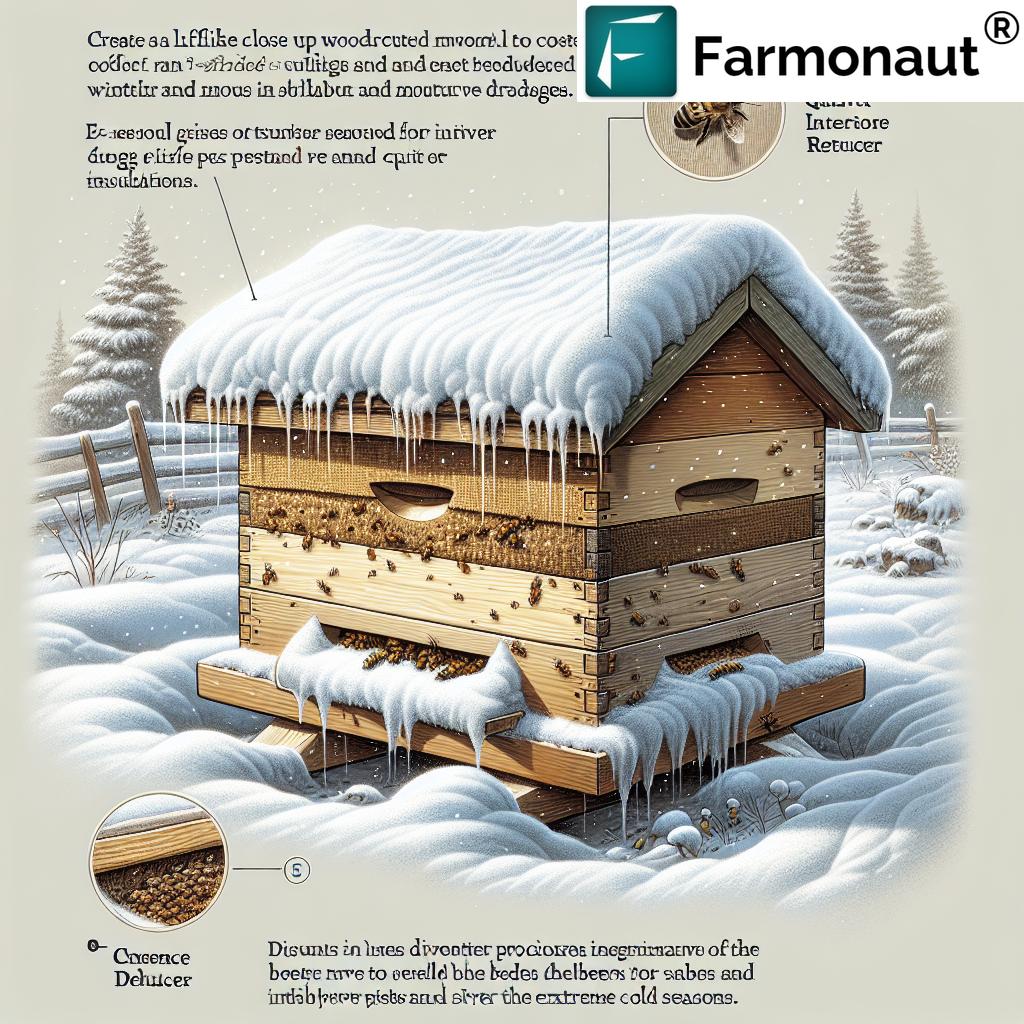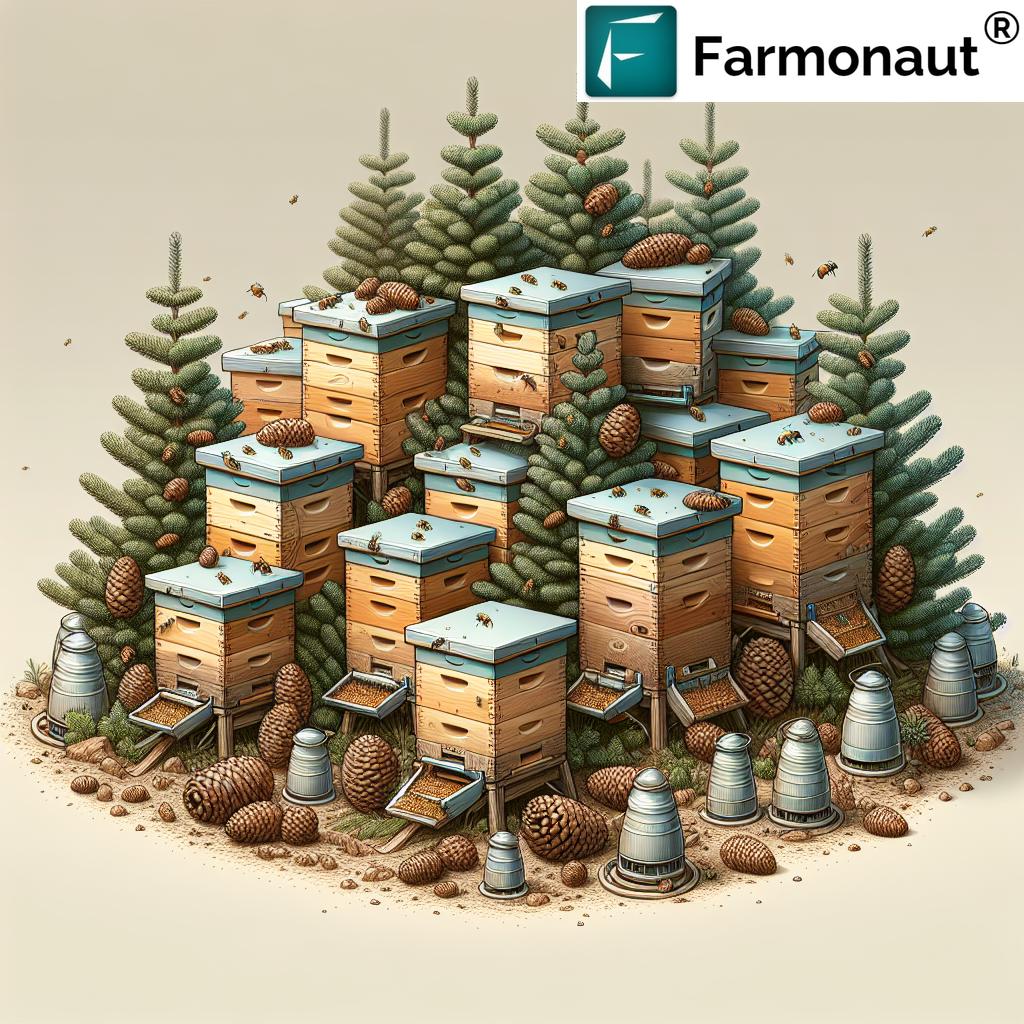Winterizing Bee Hives Canada: 10 Key Survival Tips for Harsh Winters
Meta Description: Winterizing bee hives in Canada is critical for bee colony survival during the cold months. Learn 10 essential tips for insulating hives, managing moisture, and preparing your colonies for a successful spring revival.
Why Winterizing Bee Hives in Canada Matters
Canada’s harsh winters pose significant challenges for bee colonies. As beekeepers, winterizing beehives is not merely a routine—it’s a critical practice that ensures bee colony survival in winter, prevents excessive colony loss, and supports the productivity of hives throughout the coming spring. Whether you’re in Manitoba, Alberta, Quebec, Ontario, or the Maritimes, understanding the unique climatic conditions and adapting hive management practices is essential for healthy bees and successful honey harvests.
- Harsh winter conditions cause cold stress and increased moisture inside the hives.
- Poor ventilation and insulation can result in heat loss, increased condensation, and eventual colony death.
- Pests and predators are attracted to weakened hives, adding further risk.
- Strong colonies with adequate honey stores and effective moisture management are more likely to thrive, leading to robust spring revival and increased pollination productivity.
By following science-backed, practical steps for insulating beehives for winter, reducing hive entrances in winter, and managing moisture in bee hives, beekeepers can protect their colonies from the most severe Canadian winter conditions. Let’s explore the top 10 key survival tips for winterizing bee hives in Canada.
10 Essential Tips for Winterizing Bee Hives in Canada
1. Assessing Colony Health and Honey Stores
The first step in effective winterizing beehives is a comprehensive evaluation of colony health and honey stores. Healthy colonies remain productive and capable of surviving the harsh conditions of Canadian winters. Begin by examining these aspects:
- Queen Health: Ensure you have a strong, healthy queen actively laying eggs into late summer, producing winter bees. Winter bees can live up to six months, forming the workforce essential for overwintering (source).
- Brood Patterns: Check for consistent brood patterns and absence of disease.
- Honey Stores: Colonies typically require between 40 to 60 pounds (18–27 kg) of honey to sustain themselves through winter. Too little honey will leave bees at risk of starvation.
- Supplemental Feeding: If honey is inadequate, consider feeding supplemental sugar syrup (2:1 sugar-to-water ratio) or candy boards to build up bee reserves. This step should be completed before temperatures drop steadily below 10°C/50°F.
Learn more at beekeeping-101.com. - Pollen Check: Check for sufficient pollen stores so winter bees can maintain brood rearing as spring approaches.
Key Takeaway: Only robust, adequately supplied colonies should be overwintered. Weak hives can be consolidated with stronger ones.
2. Reducing Hive Entrances in Winter
Reducing hive entrances in winter is essential for protecting bees from cold weather and potential predators like mice. Large entrances allow cold winds to directly enter the hive, increasing the risk of chilling and robbing. Smaller entrances help:
- Maintain hive temperature: Bees expend less energy to stay warm.
- Prevent cold drafts: Reduces loss of precious internal heat and moisture disruption.
- Protect from predators: Mice and wasps are less likely to invade smaller entrances.
Install an entrance reducer (wooden block with a small opening) or use natural materials like pinecones and sticks to close off up to 75% of the hive entrance. Ensure reduced openings still allow for adequate bee flight on rare warm days.
Discover more at vancouverbeeproject.org.
3. Managing Moisture in Bee Hives
Managing moisture in beehives is perhaps the most critical factor for colony survival. Excess moisture can condense on the hive lid, drip back onto bees, and cause chilling or death—even more dangerous than cold alone. To control moisture:
- Top Ventilation: Drill a small upper entrance or notch in the inner cover to allow excess moisture and CO2 to escape.
- Moisture Quilts: Install a box filled with absorbent materials (e.g., wood shavings, burlap) above the brood nest. These moisture quilts wick dampness away and help reduce condensation events.
- Slanted Roofs: Tilt hives slightly forward so any condensation drains out the entrance, not onto the cluster below.
Learn more about how to winterize a beehive and control moisture at Vancouver Bee Project.
4. Insulating Beehives for Winter
Proper insulating beehives for winter ensures bees spend less energy maintaining warmth, minimizing food consumption and cluster stress. In most Canadian provinces, standard single-wall hives offer little protection against extended sub-zero temperatures and biting winds.
- Hive Wraps: Apply black tar paper or insulated wraps. Black absorbs solar heat, while insulation buffers against overnight cold snaps.
- Insulated Tops: Use foam boards or commercial insulated covers on hive lids. Always allow some ventilation above insulation.
- Insulation Alternatives: Straw bales or rigid foam can also be effective windbreak-insulation combos.
Balancing insulation and moisture control is important—avoid making hives too airtight. For more details, visit Backyard Beekeeping.
5. Installing Windbreaks Around the Hive
Installing windbreaks is crucial for protecting bees from cold weather and reducing the energy they must expend to stay warm inside the cluster. Canadian winters are notorious for howling winds and drifting snow, which can rapidly cool unprotected hives.
- Types of Windbreaks: Use wooden fences, straw bales, snow fences, or plantings of evergreen shrubs/windbreak trees about six feet from hives.
- Benefits: Physical barriers slow wind velocity, reduce snow build-up at the entrance, and create a slightly warmer microclimate.
- Positioning: Ensure windbreaks don’t block upper ventilation or create air stagnation, as this may worsen moisture control issues.
For more on wind protection and hive placement tips, see Bee Professor.
6. Preventing Pests and Rodents in Beehives
Preventing pests in beehives—especially rodents and small mammals—is vital. Hives become attractive winter homes due to food, dry shelter, and warmth.
- Mouse Guards: Fit metal mouse guards or tight hardware cloth over reduced entrances (8mm or 5/16″ gaps are sufficient for worker bees but keep mice out).
- Hive Cleaning: Keep the area around each hive cleared of tall grass, debris, and brush to discourage nesting and prevent predators from sneaking close.
- Routine Checks: During winter thaws, check entrances for damage or blockages caused by rodents, dead bees, or ice.
Learn more about protecting hives from mice and other winter predators at Bee Professor.
7. Monitoring for Pests, Diseases, and Mites
Disease and pest infestations, such as Varroa mites, can drastically reduce colony survival rates. Winterized hives with unchecked mite loads or fungal/bacterial infections risk collapse—even if all other winterizing steps are meticulous.
- Varroa Checks: Conduct mite counts in late summer/fall (Small Farm Canada), and treat with formic acid, oxalic acid, or thymol as appropriate.
- Other Pests/Diseases: Watch for symptoms of AFB, chalkbrood, and nosema—treat or requeen as needed before winter.
- Treat Promptly: Only strong, healthy colonies should be overwintered. Prompt treatment saves colonies and maintains overall apiary health.
8. Consolidating Hive Space
Reducing and consolidating hive space helps bees maintain internal warmth and stay productive with less energy expenditure.
- Frame Arrangement: Move all brood and heavy honey frames to the center, directly above and around the winter cluster.
- Empty Frames: Place empty or partially filled honey frames to the hive’s outer sides or remove them entirely.
- Benefits: A compact cluster allows bees to move up through honey stores without encountering empty, cold space—a vital survival strategy.
This is a crucial step in how to winterize a beehive. Discover more at Beekeeping 101.
9. Providing a Winter Water Source
Yes, even in subzero conditions, bees require access to water. Internal hive moisture alone isn’t sufficient for all physiological needs, especially when brood rearing resumes before foraging is possible.
- Bee Waterer Placement: Place a shallow dish or pan near the hive (protected from wind), partially filled and unfrozen.
- Float Materials: Add corks, pebbles, or wood chips as landing zones for bees to prevent drowning.
- Monitor Regularly: During midwinter thaws, check and refill water sources and ensure they remain ice-free and clean.
For more details on keeping bees hydrated in the cold months, visit Beekeeping 101.
10. Bee Hive Preparation for Spring – Supporting Spring Revival
Winterizing beehives is not complete without planning for an efficient spring revival:
- Remove Insulation & Wraps: As soon as warm, consistent weather returns, take off hive wraps, insulation, and windbreaks to avoid overheating and improve ventilation.
- Inspect Colony Health: Check for queen rightness, population, stores, and signs of pests or disease.
- Feed as Needed: If reserves are low, provide supplemental feed (e.g., sugar syrup, protein patties) to jump-start spring buildup.
- Monitor & Expand: Install new frames or supers as colonies grow and foraging resumes.
Proper preparation ensures colonies remain healthy, productive, and resilient throughout the cold months and into a successful spring revival.
Winterizing Bee Hives: Tip Comparison Table
Use this table to compare our 10 key survival tips for winterizing bee hives in Canada. Each tip is rated by purpose, expected implementation time, and effectiveness—making it easy for beekeepers to prioritize the best winter preparation strategies.
| Winterizing Tip | Purpose/Benefit | Est. Implementation Time | Effectiveness (1–5) |
|---|---|---|---|
| Assess Colony Health & Stores | Ensures only robust, healthy, and adequately supplied hives overwinter, maximizing spring revival | 45–90 minutes/hive | 5 |
| Reduce Hive Entrances | Reduces cold drafts and predator access; preserves heat in hive interior | 10 minutes/hive | 5 |
| Manage Moisture & Ventilation | Prevents condensation-related deaths and disease inside hive | 30–40 minutes | 5 |
| Insulate the Hive | Maintains stable temperature, reduces bee energy use and food needed for warmth | 15–25 minutes/hive | 4 |
| Install Windbreaks | Shields colony from prevailing winds; reduces chilling and snow drift risk | 30–60 minutes/apiary | 4 |
| Prevent Rodent Infestation | Stops damage to frames, honey, and colony from mice/rodents | 15 minutes/hive | 4 |
| Monitor for Pests & Diseases | Avoids colony collapse from mites and infectious diseases | 30 minutes/hive | 5 |
| Consolidate Hive Space | Keeps bee cluster compact for warmth; easier to access honey stores | 15–30 minutes/hive | 4 |
| Provide Water Source | Prevents dehydration and supports early spring brood rearing | 10 minutes/hive | 3 |
| Prepare for Spring | Ensures swift colony expansion and health in new season | 45 minutes/hive | 5 |
Advanced Technology & Support for Canadian Beekeepers
Canadian beekeepers face unique winter challenges—with climate variability, harsh temperatures, and the need to maximize resource efficiency. Leveraging innovation for modern hive management can dramatically improve results.
- Farmonaut provides advanced, satellite-based crop health monitoring and resource management—allowing efficient land use and proactive apiary management, especially useful for beekeepers who also cultivate bee-friendly crops.
- Our large-scale farm management solutions help agricultural producers (including beekeepers managing pollination services) monitor fields, optimize resources, and predict seasonal changes that impact hive health.
- The carbon foot-printing tool aids apiary owners in tracking sustainability and reducing environmental impacts, which is increasingly essential for pollinators’ well-being.
- Maintain transparency and improve consumer trust in honey products with blockchain-based traceability, a growing trend in Canadian and global markets.
- Insurance and loan access for large operations is enhanced by satellite-supported verification and reporting.
Ready to improve your beekeeping and agricultural operations? Explore our complete Farmonaut API and dig into developer documentation for custom integrations.
FAQ: Winterizing Bee Hives in Canada
What is the best way to winterize beehives in Canada?
The most effective strategy involves a multifaceted approach: assess colony health, ensure adequate honey stores, reduce hive entrances, manage moisture with proper ventilation, insulate hives for winter, install windbreaks, prevent rodents and pests, consolidate hive space, provide a winter water source, and prepare for a strong spring revival.
How much honey do I leave for bees in a Canadian winter?
A healthy, strong colony typically requires 40 to 60 pounds (18–27 kg) of stored honey. Monitor stores by gently lifting hives or using a hive scale; replenish as needed with supplemental feeding before consistent freezing weather.
Why is managing moisture in beehives critical in winter?
Excess hive moisture can condense and drip onto the bee cluster, leading to fatal chilling. Adequate ventilation and moisture quilts help wick away condensation, ensuring bee colony survival in winter.
Do I need to insulate hives in all parts of Canada?
In most of Canada, insulating beehives for winter is highly recommended. Severe cold, wind, and drastic temperature swings are common in nearly all provinces except possibly the coastal zones of BC. Use tar paper wraps or insulated covers.
How do I prevent mice from entering hives during winter?
Fit tight-fitting metal mouse guards or hardware cloth over the hive entrance, maintaining openings small enough (about 8 mm) for bees but too small for rodents. Keep hive areas clear of weeds and brush to further deter rodents.
Can I open my hive in winter?
Avoid opening the hive during freezing temperatures—this rapidly cools the cluster and can dislodge moisture control. Only lift outer covers briefly during mild spells or to clear entrances if blocked.
Is supplemental feeding necessary for winterized beehives?
Feed bees with sugar syrup in autumn if honey stores are insufficient. During winter, avoid liquid feed—use fondant or candy boards if reserves run low during late winter/early spring.
What should I do first in spring after winterizing beehives?
Remove insulation/wraps, inspect colonies for queen health, population, store levels, and diseases, and begin supplemental feeding and expansion as needed. This sets up the hive for a productive spring and summer.
Conclusion: Ensuring Productive Colonies and Spring Revival
Proper winterizing of bee hives in Canada is essential for overcoming harsh winter conditions and ensuring the survival, revival, and productivity of your colonies. Start with health assessments, honey store checks, and robust moisture management strategies. Reduce entrances and insulate for warmth, protect against rodents and pests, consolidate frames, supply winter water sources, and plan for spring as the weather shifts.
As technology advances, beekeepers have new tools and insights to monitor and improve hive survivability. At Farmonaut, we are dedicated to bringing affordable, precision agriculture solutions—including satellite-based farm monitoring, AI-driven advisory, and blockchain traceability—to farmers and beekeepers throughout Canada and beyond. These innovations empower more informed decisions, sustainable practices, and a brighter future for healthy bees and bountiful farms.
Winterizing beehives is not just maintenance—it’s a critical practice, a tradition, and a means of safeguarding the very foundation of pollination agriculture in the northern climate.


















